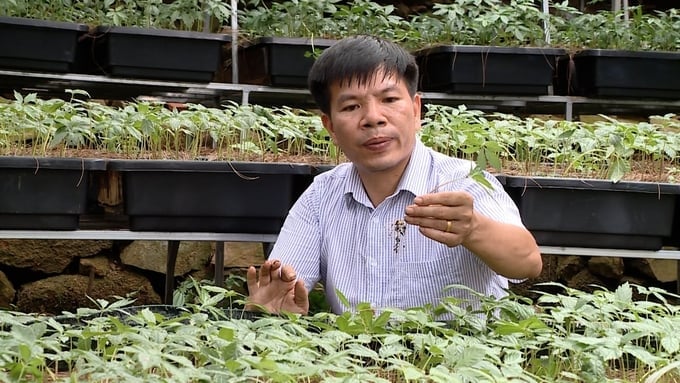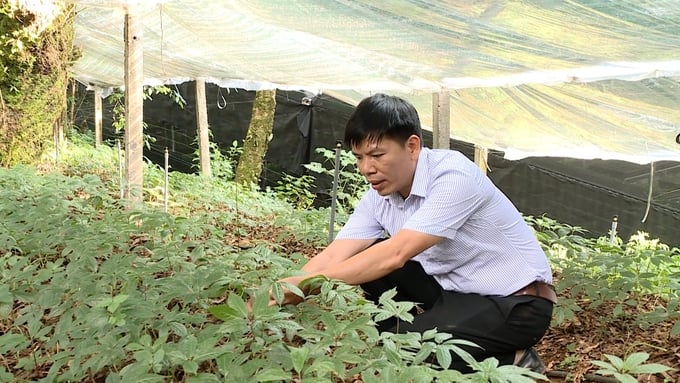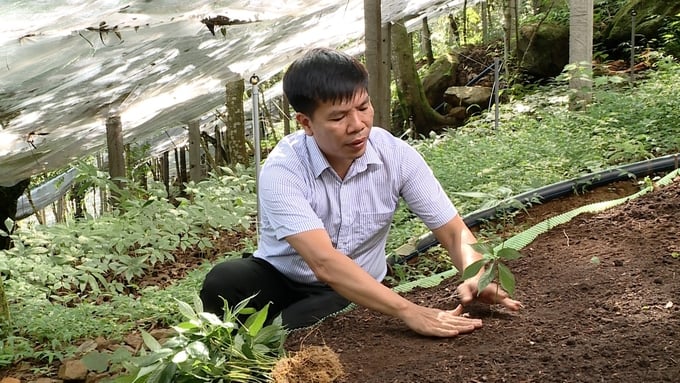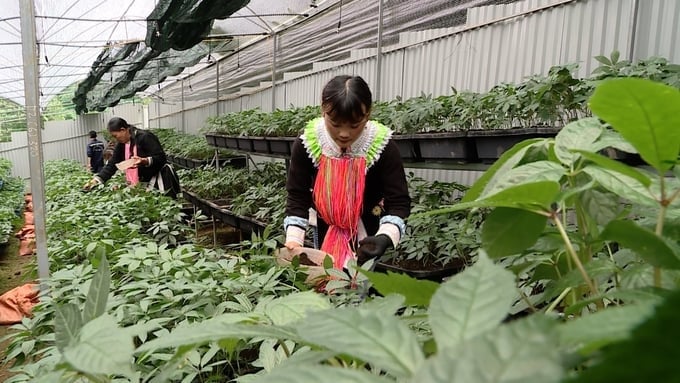June 21, 2025 | 01:55 GMT +7
June 21, 2025 | 01:55 GMT +7
Hotline: 0913.378.918
June 21, 2025 | 01:55 GMT +7
Hotline: 0913.378.918
Lai Chau province, with its high mountainous terrain at over 1,000 meters above sea level, boasts extensive areas of pristine forests and a cool, temperate climate throughout the year. Beneath these forests, several valuable medicinal plants can be found, including Lai Chau ginseng and other herbs. The Lai Chau ginseng is primarily found at altitudes ranging from 1,400 to 2,200 meters above sea level. Lai Chau province is currently promoting the cultivation and development of Lai Chau ginseng in order to effectively harness the potential and value of this rare medicinal plant.

Dr. Pham Quang Tuyen, a researcher at the Silviculture Research Institute under the Vietnamese Academy of Forest Sciences, has dedicated over ten years of his career to the study and conservation of Lai Chau ginseng. Photo: Duy Hoc.
Recognizing the potential and value of Lai Chau ginseng, the Ministry of Agriculture and Rural Development has assigned the Vietnamese Academy of Forest Sciences to deploy the project titled "Study, Restoration, and Development of the Gene Source of Lai Chau Ginseng (Panax vietnamnensis var. Fuscidiscus) in the Northwest region of Vietnam." The project will be conducted from 2022 to 2024 under the leadership of Dr. Pham Quang Tuyen, who is affiliated with the Silviculture Research Institute under the Vietnamese Academy of Forest Sciences. Accordingly, the project has yielded promising results, opening up significant prospects for the economic development of Lai Chau ginseng.
Dr. Tuyen shared that during his research on Lai Chau ginseng, he was fortunate to be assigned a research project by the Lai Chau Department of Science and Technology to study and survey rare medicinal plants in the Muong Te region. Thanks to the aforementioned project, he discovered a valuable medicinal plant that locals referred to as "black ginseng", which is subsequently recognized as Muong Te ginseng or Lai Chau ginseng.
"We collected the initial genetic resources of Lai Chau ginseng and laid the first foundation for its cultivation and development in Muong Te District. The project has since spread to four districts in the province, including Tam Duong, Muong Te, Sin Ho, and Phong Tho," Mr. Tuyen added.
According to Mr. Tuyen, although most locals were familiar with Ngoc Linh ginseng, the Lai Chau ginseng received little recognition because it is a relatively new species under study. However, both Lai Chau ginseng and Ngoc Linh ginseng belong to the same Panax vietnamensis species.

According to Dr. Pham Quang Tuyen, the conservation and propagation of Lai Chau ginseng are challenging tasks. Photo: Duy Hoc.
Ngoc Linh ginseng is naturally distributed in the Ngoc Linh mountain range in the Kon Tum and Quang Nam provinces. In contrast, Lai Chau ginseng is found in high mountain ranges such as Pu Si Lung and Pu Sam Cap in Lai Chau province.
According to Dr. Tuyen, his research team observed certain similarities with Ngoc Linh ginseng after analyzing the medicinal components of Lai Chau ginseng. Most notably, six-year-old Lai Chau ginseng was shown to contain a high content of saponin, with some samples reaching 23 to 25% of the total saponin content.
Additionally, Lai Chau ginseng exhibits robust growth and possesses a diverse range of genetic resources and germplasm. There are various morphological characteristics and different attributes among the plants.
"With rich genetic resources, we can select the best strains for the development of Lai Chau ginseng. For instance, we can identify strains that are disease-resistant, have high medicinal content, and especially those that combine strong growth and high medicinal content with disease resistance. This lays the groundwork for a sustainable propagation," Mr. Tuyen explained.
However, the conservation and propagation of Lai Chau ginseng are challenging tasks. According to Mr. Tuyen, Lai Chau ginseng has an extended dormant period, which can last from five to six months, followed by at least a year of nurturing in the nursery to meet seedling standards before cultivation. Additionally, ginseng cultivation under the natural forest canopy faces the risks of pests and diseases. Furthermore, due to its high economic value, managing and protecting Lai Chau ginseng is exceptionally challenging.

According to Dr. Pham Quang Tuyen, the cultivation of Lai Chau ginseng under the natural forest canopy in conjunction with protective structures should be encouraged. Photo: Duy Hoc.
Furthermore, Lai Chau ginseng thrives in high mountain ecosystems, which are home to ethnic minority communities, with some belonging to the endangered ethnic groups in Vietnam. Due to its remote and challenging location, there is limited access to technical knowledge and production expertise.
Another challenge is the difficulty of transportation for ginseng propagation and development. Dr. Pham Quang Tuyen's research team had to trek regularly, even during heavy rains, on dangerous landslide-prone roads in order to collect and deliver ginseng samples.
Dr. Tuyen emphasizes that the research and development of Lai Chau ginseng requires support solutions from governmental agencies, including building infrastructure and establishing training programs to promote knowledge and production techniques to local communities. Furthermore, the government needs to enable scientists and technical transfer personnel, with a focus on agricultural extension officers at the provincial and district levels, to provide on-site guidance and technology transfer to local farmers.
According to Dr. Tuyen, South Korea primarily employs three cultivation methods for ginseng. Firstly, they cultivate ginseng in a natural mountainous setting, where seeds or seedlings are released into the wild with minimal initial intervention, allowing the plants to grow naturally. This method yields high-value ginseng. Secondly, they cultivate ginseng in concentrated ginseng fields for large-scale industrial production, which serves as a source of raw materials. Thirdly, they cultivate young ginseng plants for medicinal herb use, with the assistance of advanced agricultural technologies.
On the other hand, Vietnam currently employs two main methods for cultivating and developing Lai Chau ginseng. One method involves growing ginseng under the natural forest canopy, whereas the other utilizes greenhouse cultivation in regions with favorable climatic conditions. Both methods have their own advantages and disadvantages.

Lai Chau ginseng is similar to Ngoc Linh ginseng, both of which can be categorized as the world's finest ginseng varieties with exceptionally high economic value. Photo: Duy Hoc.
Dr Tuyen's analysis suggests that a wholly natural approach, which involves direct seed sowing within forested areas to enable the natural growth of ginseng, can potentially produce ginseng plants that closely resemble their wild counterparts. This method, while leading to high-value ginseng that readily meets pharmaceutical standards and garners market preference, poses the challenge of low yield and demands significant initial time and investment.
Conversely, the method of ginseng cultivation in concentrated areas under protective structures would result in higher quantities of ginseng, a shorter harvest time, and simplified management. As a result, in order to maintain a harmonious balance between advancing large-scale commercial production and maintaining the production of high-value Lai Chau ginseng, it is imperative to gradually refine the technical procedures for each cultivation method to enhance overall efficiency.
TS Tuyen asserts, "The cultivation of Lai Chau ginseng under the natural forest canopy in conjunction with protective structures should be encouraged. Within this production model, stringent management pertaining to pest and disease control is essential, and thorough soil preparation is imperative before commencing the cultivation."
Furthermore, comprehensive technical guidance through well-structured documentation, training initiatives, and public awareness campaigns is indispensable. This level of guidance is essential to aid businesses, cooperatives, and local communities in adopting organic and biologically oriented cultivation practices. These practices not only assure the quality of ginseng medicinal materials but also fulfill the requisites for strong growth, sustainable development, and heightened survival rates, thereby securing a stable income for local inhabitants.
In the estimation of Dr. Pham Quang Tuyen, the cultivation of Lai Chau ginseng may prove to be challenging in areas where their natural growth is absent. Howeover, with a profound comprehension of Lai Chau ginseng's specific cultivation prerequisites, it remains possible to cultivate this plant in regions featuring similar climatic and soil conditions, such as Dien Bien, Lao Cai, and Yen Bai, to generate marketable products. However, this endeavor should be approached with prudence, mandating comprehensive research, rigorous testing, and thorough evaluations before undertaking large-scale production.
Translated by Nguyen Hai Long
![Turning wind and rain into action: [9] Digitizing hydrometeorological data in response to climate change](https://t.ex-cdn.com/nongnghiepmoitruong.vn/608w/files/news/2025/06/17/z6704423696987_15fd32ffc26d590d204d520c9dac6786-nongnghiep-165943.jpg)
(VAN) Farmers have begun accessing hydrometeorological applications to adjust their cropping schedules, aiming to ensure productivity and adapt to climate change.
![Turning wind and rain into action: [8] Real-time salinity detection and early warning technology](https://t.ex-cdn.com/nongnghiepmoitruong.vn/608w/files/news/2025/06/17/z6704423696987_15fd32ffc26d590d204d520c9dac6786-nongnghiep-151127.jpg)
(VAN) Thanks to the integration of modern hydrological-hydraulic models, remote sensing technologies, and artificial intelligence, the accuracy of hydrological forecasting has significantly improved.
![Turning wind and rain into action: [7] Early disaster warnings help marine farmers minimize losses](https://t.ex-cdn.com/nongnghiepmoitruong.vn/608w/files/news/2025/06/17/z6704423696987_15fd32ffc26d590d204d520c9dac6786-nongnghiep-142942.jpg)
(VAN) In recent years, thanks to early disaster warnings and forecasting, marine farmers in Khanh Hoa province have been able to reduce risks and losses, thereby improving production efficiency.
![Turning wind and rain into action: [6] ‘Four on-the-spot’ disaster management software](https://t.ex-cdn.com/nongnghiepmoitruong.vn/608w/files/news/2025/06/17/e5a48259d6a262fc3bb3-nongnghiep-183800.jpg)
(VAN) By simply activating the scenario on the disaster management software, the relevant authorities immediately know how many households need to be evacuated, where to evacuate them to, and by what means of transportation…
![Turning wind and rain into action: [5] Hue applies modern technology in disaster forecasting](https://t.ex-cdn.com/nongnghiepmoitruong.vn/608w/files/news/2025/06/17/z6704423696987_15fd32ffc26d590d204d520c9dac6786-nongnghiep-093938.jpg)
(VAN) In Hue city, modern technology has recently been applied in meteorological and hydrological forecasting and warning, helping to reduce the damage caused by natural disasters.

(VAN) A cutting-edge farming technique being implemented on an experimental ranch in Arizona's Sonoran Desert has already saved a billion gallons of water over five years, according to Civil Eats.

(VAN) Poultry and pig production and the environment can be boosted through enhanced water technology, according to new research.